Seasonal Maintenance Tips for Protecting Coatings in New Zealand
Understanding the Importance of Seasonal Maintenance
In New Zealand, the changing seasons bring unique challenges when it comes to maintaining protective coatings. These coatings are essential for safeguarding surfaces against environmental factors such as moisture, UV rays, and temperature fluctuations. As each season presents different conditions, it's crucial to adapt your maintenance routine to ensure the longevity and effectiveness of these coatings.
Seasonal maintenance not only helps in prolonging the life of coatings but also enhances the appearance and performance of the surfaces they protect. By following a few key maintenance practices, you can prevent potential damage and costly repairs down the line.

Spring: Preparing for Growth and Renewal
Spring in New Zealand is a time of renewal, making it the perfect season to assess the condition of your coatings after the harsh winter months. Begin by conducting a thorough inspection for any signs of wear, such as cracking or peeling. Addressing these issues early can prevent further deterioration.
During spring, increased rainfall is common, which can lead to moisture build-up. Ensure that all surfaces are properly sealed to prevent water infiltration, which could compromise the coating. Additionally, consider applying a fresh layer of protective coating if necessary.
Essential Spring Maintenance Steps
- Inspect for damage or wear
- Seal surfaces against moisture
- Consider reapplying protective coatings

Summer: Guarding Against UV Damage
Summer brings longer days and increased exposure to sunlight, which can be damaging to coatings. Ultraviolet (UV) rays can cause fading and degradation, reducing the effectiveness of your protective layers. To combat this, ensure that your coatings contain UV inhibitors or consider applying a UV-resistant topcoat.
In addition to sun exposure, summer is often accompanied by higher temperatures. This can lead to thermal expansion and contraction of surfaces, potentially causing cracks. Regularly check for signs of heat damage and address any issues promptly.
Summer Maintenance Checklist
- Apply UV-resistant topcoats
- Monitor for heat-induced damage
- Ensure proper ventilation to reduce heat build-up

Autumn: Preparing for Cooler Months
As temperatures begin to drop in autumn, it's important to prepare your coatings for the cooler months ahead. Falling leaves and debris can accumulate on surfaces, leading to staining or abrasion if not removed regularly. Keep surfaces clean by sweeping away debris and washing them with mild detergent.
Autumn is also an ideal time to perform any necessary repairs before winter sets in. Ensure that all coatings are intact and that there are no vulnerabilities that could worsen with cold weather conditions.
Autumn Preparation Tips
- Regularly clean surfaces from debris
- Perform necessary repairs on coatings
- Check for vulnerabilities before winter

Winter: Protecting Against Cold and Moisture
Winter in New Zealand can be harsh, with cold temperatures and increased moisture posing significant threats to protective coatings. To defend against these elements, ensure that all coatings are in good condition and any gaps or cracks are sealed to prevent moisture ingress.
It's also beneficial to use anti-freeze additives in coatings where applicable, especially for surfaces exposed to extreme cold. Regular inspections throughout winter can help identify any emerging issues early, allowing for timely intervention.

By implementing these seasonal maintenance tips, you can effectively protect your coatings throughout the year, ensuring they continue to provide optimal protection and maintain their appearance. Remember, proactive care is key to avoiding costly repairs and extending the life of your coatings in New Zealand's diverse climate.